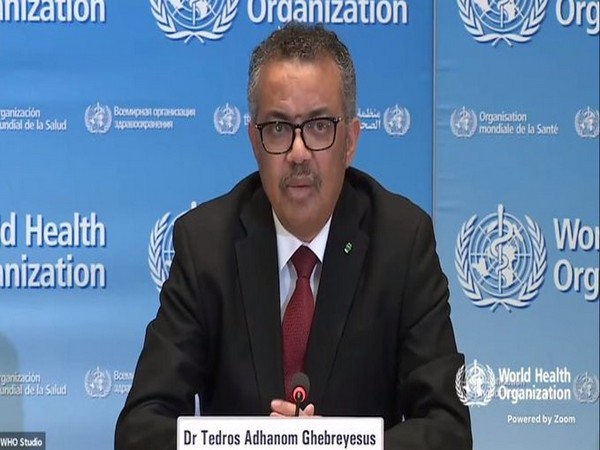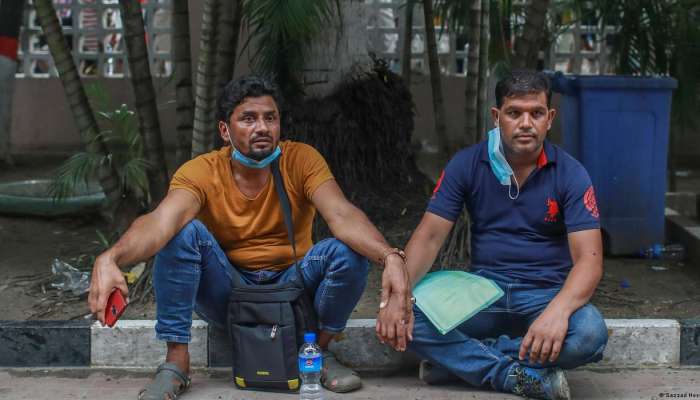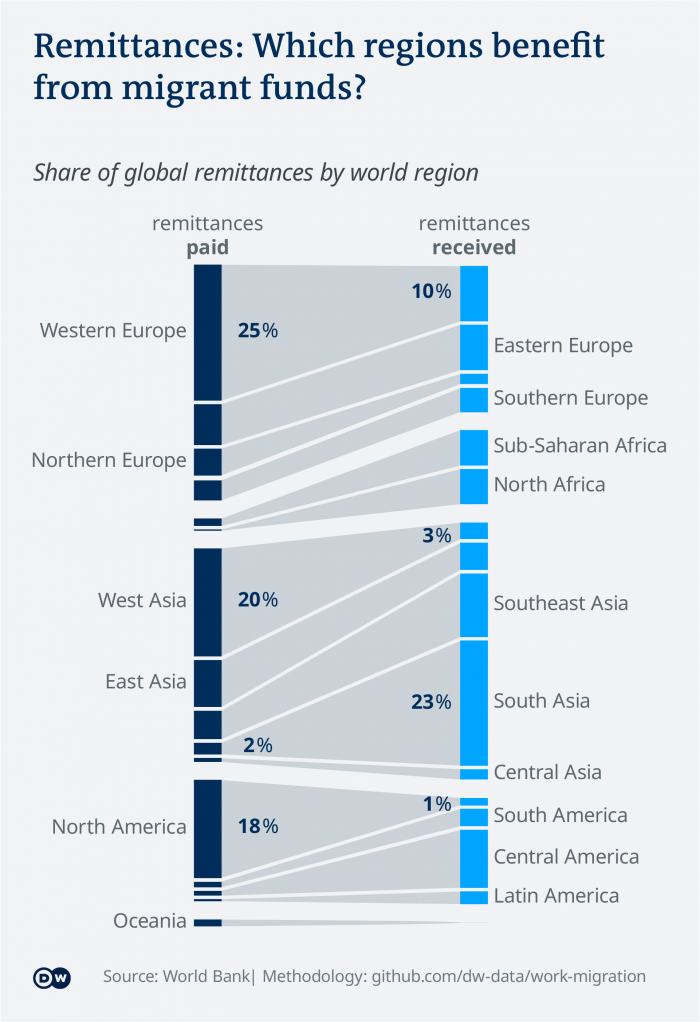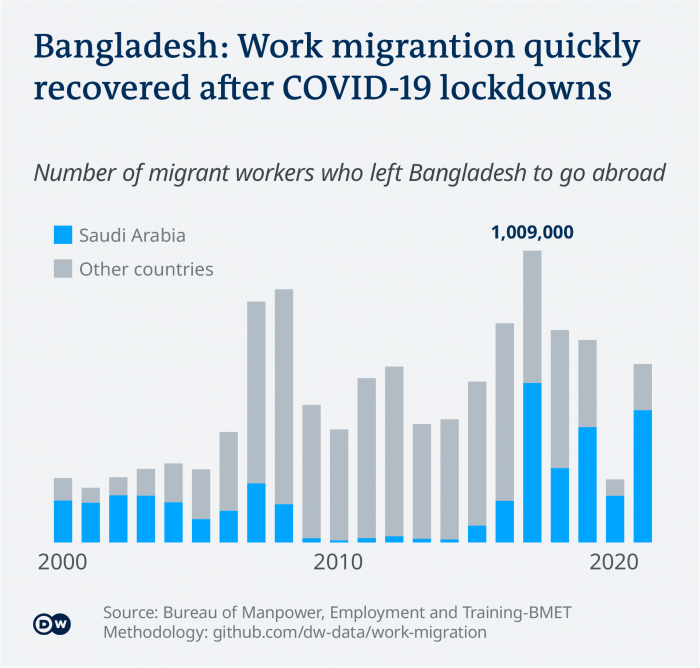

The COVID-19 pandemic brought international migration to a standstill — and migrant workers have borne the greatest cost. But Bangladeshi workers are doing surprisingly well.
Abul Basar has been in Saudi Arabia for 14 years now. After failing to find a suitable job in Bangladesh, he tried his luck as a migrant worker in the oil-rich desert state in order to support his family in Bangladesh, first in Riyadh, later in Jeddah. Most recently, he worked as a plumber at a water treatment plant in Al Qasim province. Then the coronavirus hit.
As of today, Basar is one of approximately 260 million migrants worldwide whose labor contributes to a major redistribution of capital to lower-income regions of the world. Ninety percent of what he earns — 2,000 Saudi riyals ($533, €498) a month — he sends home to support his family of four people.
More than half of all migrant workers are from South, East and Southeast Asia. They make up around 20% of the workforce in Western, Northern and Southern Europe — and the US. In the Gulf states, it's around 41%.
Europe, the US, and the Gulf States are particularly important destinations for migrant workers and the source of most remittances.
Remittances: The economic stabilizer
With their remittances, migrant workers don't just provide for their families. They also stabilize entire national economies. In Zimbabwe, Georgia, Nicaragua and Senegal, remittances account for more than 10% of the national economy. In El Salvador, Gambia, Jamaica and Nepal, it's more than 20% and in Kyrgyzstan and Tajikistan it's around 30%.
North and sub-Saharan Africa, South and Southeast Asia, and Central America benefit particularly from remittances.

With the onset of the COVID-19 pandemic, however, this model appeared to be in jeopardy. Lockdowns and job losses threatened to choke off the steady flow of capital transfers. In April 2020, World Bank experts estimated that migrants would send $129 billion less back home in the first year of the pandemic — a 20% drop.
In reality, payments recovered quickly after a brief, sharp drop. Currencies of key emerging economies such as Brazil, South Africa and Turkey depreciated sharply at the onset of the pandemic while remittances from dollar and euro economies grew in value. A large number of migrant workers also likely drew on savings in order to support their families back home, despite losing their jobs.
"Usually I send around 500,000 BDT ($5,775; €5,450) a year to my family," Abul Basar said.
But this has changed during the pandemic. Over the last two years, he tried to send more money to his family.
"In 2021, my father was infected with COVID-19 and his treatment cost over 100,000 BDT. Compromising my savings that year, I sent more than 600,000 BDT to my family for bearing their extra cost."
The 'employment gap' with the local population
So the pandemic led to a greater financial burden and to severe cuts for migrant workers. Seasonal and migrant workers in particular, who had little legal protection, quickly lost their jobs. The unemployment rate also rose among the local population in many countries. But migrant workers were more affected by layoffs. In some countries with many seasonal workers, such as Hungary, Spain and Italy, a migrant worker was 50% more likely to be unemployed compared to a local worker.
According to the International Labor Organization, a UN institution, the reason for migrant workers being more likely unemployed than the local population is that they often work in the precarious, low-wage sectors. These include industries hit particularly hard by the pandemic, such as catering, tourism, culture, retail and construction.
The true unemployment figures are likely even higher when you consider migrants who left the country due to job losses and therefore aren't counted in the statistics.
India alone counted 6.1 million stranded workers who had to be flown home on charter flights when the pandemic hit. Thailand, Nepal, Malaysia, Sri Lanka also saw hundreds of thousands leave the country, in many cases due to layoffs. The ILO says the situation in South America and Africa was similar. Migrant workers in the Arab Gulf states were affected even more.
It's unknown whether these people will be able to return to the countries where they were working anytime soon. While at the beginning of the pandemic, virtually all countries in the world closed borders to prevent travel, migration policies have varied since then: Many countries in sub-Saharan Africa quickly lifted regulations, while other European ones such as Spain and Italy tightened travel restrictions after COVID numbers increased.
Vaccination rules have also made entry more difficult. The US, EU, South Korea, the United Arab Emirates and especially Saudi Arabia not only require proven vaccination against COVID-19. At least for some time, they rejected certain vaccines produced in China, deeming them insufficient. But these were frequently used in South and Southeast Asia.
The 'Saudization' of Saudi Arabia
The restrictive policy in the gulf in particular could be due to the so-called Saudization of the economy. Underway since 2018, the government initiative requires companies to "increase the proportion of Saudi nationals in their workforce," with penalties for "firms with low percentages of Saudi workers and 'redundant' foreign workers," a study of human rights organization FairSquare Project described. The Saudi health sector, for example, has to achieve an employment quota for locals between 30% and 60%.
"Firms above the quota are granted benefits, while those below face restrictions for expat hiring," a study by Harvard University's Center for International Development indicates.
Throughout the pandemic, discrimination against foreign workers was made even worse by demonization in the media. Many reports alleged that migrant workers were driving up infection rates.
Labor migration out of Bangladesh, however, only took a short term hit from restrictions such as those in Saudi Arabia. The number of workers going abroad decreased by more than two-thirds from 2019 to 2020, the Bangladeshi Bureau of Manpower, Employment and Training documented. But since 2021, the number has risen again sharply.

For three years running, Bangladesh has broken the record for highest remittance inflows ever seen in its history. According to official estimates, the workers sent back over $22 billion in 2021.
According to Dr. Zahid Hussain, formerly lead economist of the World Bank's Dhaka office, there are two special factors behind the recent record remittance inflow in Bangladesh. First, migrant workers likely sent more remittances through unofficial channels than the legal ones.
"Because of the complete disruption of unofficial channels during the pandemic time, they have been forced to choose the latter one," Hussain said.
Many also transferred their savings to Bangladesh amid fear of losing their jobs.
"Some may have returned to the country with all their savings because they did not have a job," he said. "This may help boost the remittance inflow of the last two years."